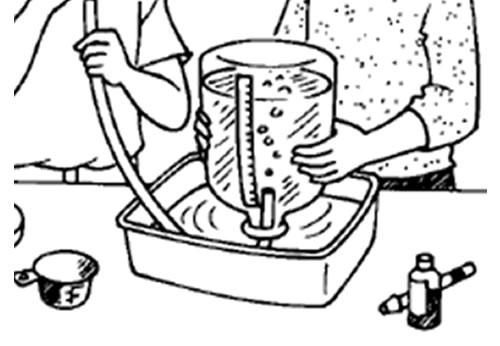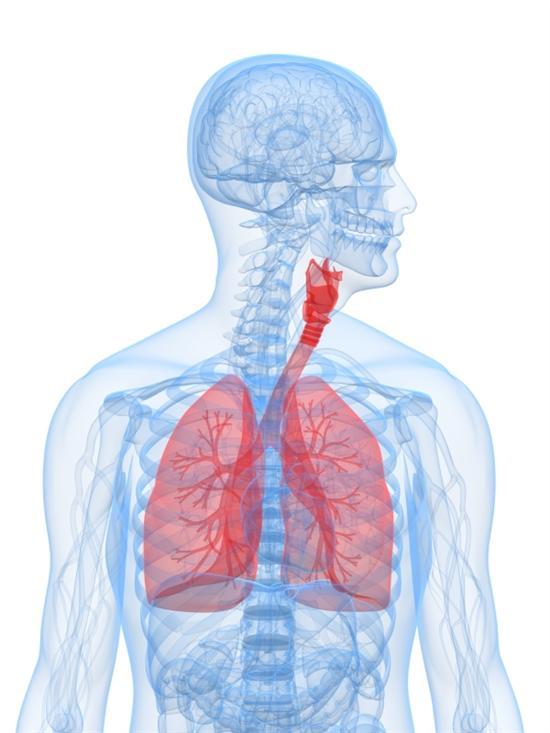| Complexity level: | 5 |
| Time required: | Finding volunteers and organising them to take the test may take several days. The set-up and test itself only takes a few minutes. |
| Safety concerns: |
Hypothesis
Overview
The maximum amount of air one can force out of his or her lungs with one exhale determines lung capacity. To measure this, a technique called water displacement method is used. This method is quite simple: the air takes the place of the water in the bottle. To use the water displacement method, take a big, deep breath then blow fully into a tube connected to a container filled with water. The resulting volume (amount) of water that is pushed out is equal to the volume of air the lungs can hold. But how does this determine someone's fitness level?
The more air capacity in the lungs, the more efficiently the body can distribute oxygen to the muscles during exercise. Oxygen is vital for muscles to work properly. That is because working muscles use oxygen to create the energy necessary to function. With regular exercise, one's cardio-respiratory function improves (cardio, referring to the heart, and respiratory referring to lungs). If one exercises regularly, their body becomes more efficient at bringing in, transporting, and using oxygen. Increasing the intensity of regular workout results in even greater the benefits to cardio-respiratory function and lung capacity. This improves the VO2 max, which is the maximum oxygen consumption during exercise. VO2 max comes from V for volume, O2 for oxygen, and max for maximum. Therefore, regular and intense exercise results in larger lung capacity. This is one measurement of someone being fit.
Scientific Terms
Materials
- 7-10 volunteers with varying fitness levels
- Fitness survey
- 2-liter plastic bottle or 1-gallon plastic jug
- plastic dish pan
- masking tape
- permanent marker
- clear, bendable plastic tubing (must fit into neck of plastic bottle or jug)
- large liquid measuring cup that is labeled with ounces
- white vinegar
- water
- small cup
- paper towels
Procedure

Experiment Set-Up
1. Create a Fitness Survey and give it to 7-10 volunteers. The survey should look like this with enough rows for all the volunteers being surveyed.
|
Name |
Age |
Average days per week of exercise |
Typical intensity level during exercise |
Capacity #1 |
Capacity #2 |
Capacity #3 |
Average Capacity |
|
low moderate intense |
2. Clean the plastic tubing by rinsing it several times with warm water.
3. Fill the plastic dish plan with about 10cm.
4. Place a strip of masking tape vertically along the bottle from the top to the bottom. Pour in 10 ounces of water at a time. For every 10 ounces, mark and label the masking tape.
5. Fill the plastic bottle completely to the top with water. Put your hand over the top of the bottle and turn it upside down so that no water is escaping. Place the bottle upside down under the water in the dishpan, and then remove your hand.
6. Have your volunteer hold the bottle in the water. Push one end of the plastic tube into the bottle. Make sure the neck of the bottle stays under the water while inserting the tube.
7. For each volunteer, have he/she take in a big breath, then breathe out as much air as possible through the tube until their lungs feel completely empty.
8. Measure the volume of water displaced by reading the 10-ounce increments marked on the tape and record on the survey sheet.
9. Give the volunteer a 2-minute break between trials. While they are getting their break, refill the bottle to the top with water. Each volunteer blows three times. Record each trial and then average the three capacities measured.
10. Repeat step # 6-9 for each volunteer. Before each new volunteer, clean the opening of the tubing: in the small cup, pour half vinegar and half water to dilute the vinegar. Clean the opening of the tubing with diluted vinegar between volunteers. Dry with a paper towel.
11. Evaluate whether lung capacity correlates to your volunteers fitness level indicated on their survey. Did those who exercised more regularly and more intensely have greater lung capacity?

References
Sulzer, Jesse (ND). Aerobics and Lung Capacity. Healthy Living. Retrieved December 14, 2013 from http://healthyliving.azcentral.com/aerobics-lung-capacity-2427.html.

